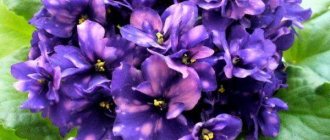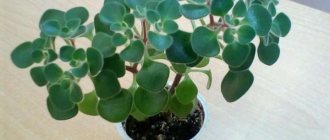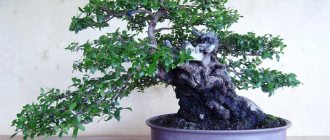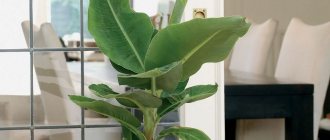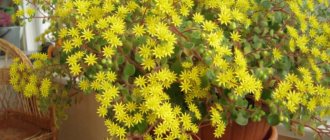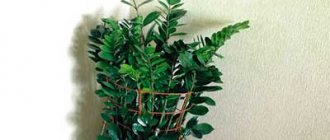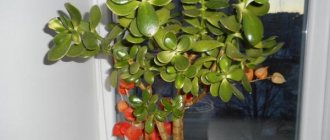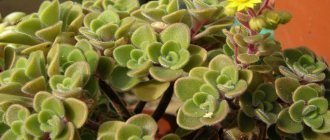Synadenium from the Euphorbiaceae family belongs to succulent plants. An exotic representative of the flora came to the windowsills of apartments and houses from the tropical and subtropical zones of arid Africa.
In literature and in everyday life, you can often find another name for the flower - the tree of love (why the plant is called this still remains unknown).
Description and popular types
Synadenium in the wild is represented by succulent trees and shrubs with thick, erect stems and dense oval-shaped leaf plates, which are attached with short petioles. The arrangement of glossy, leathery leaves is opposite or alternate. In the wild, the genus has about 20 varieties, of which only two are common in indoor floriculture:
- Synadenium Grantii is a branching shrub with numerous shoots. Thanks to pinching, you can achieve the formation of a standard tree. The color is rich green. However, variegated varieties are sometimes found.
- Synadenium Rubra - a distinctive characteristic of the species are large leathery leaf plates, painted with burgundy patterns of various shapes.
Blooming synadenium
The tree of love or Euphorbia palmum in its natural habitat blooms in the winter season, when flower stalks of varying lengths develop from the upper axils of the leaves, depending on the species.
The arrows are crowned with umbrella inflorescences, consisting of small red flowers, which are shaped like bells. Over time, in place of the flowers, seed pods are formed, divided into 3 segments.
At home, witnessing the flowering of synadenium is very rare.
Features of growing a flower and creating optimal conditions
Despite the fact that the flower is an unpretentious indoor crop, in order to grow a healthy exotic plant in the house, you should take into account a number of its features and create growing conditions close to natural ones.
Requirements for the placement of synadenium and lighting
A native of Africa loves a large amount of bright, but soft light , which he can receive through windows of eastern or western orientation.
If you install a pot with synadenium on the windowsill of southern windows, you should organize shading during the midday hours, when active sunlight can cause burns on the beautiful leaves of the flower.
In winter, when daylight hours are reduced and the temperature remains at the same level, it is recommended to provide artificial lighting to prevent the plant's shoots from stretching.
Temperature
During the period of intense flower growth, the optimal temperature regime is 22-25°C. With the arrival of autumn cold, if it is not possible to install an additional light source, it is recommended to reduce the room temperature to 15°C.
Carefully! The critical minimum for synadenium is 10°C.
Humidity
The drought-resistant succulent adapts perfectly to dry indoor air and does not need to additionally increase the humidity level.
As a hygienic procedure, the purpose of which is to clean the shoots from dust, the leaves are wiped with a damp sponge.
Soil requirements
Synadenium is not picky about soil composition and does well in a loose substrate with a neutral reaction. You can prepare the soil mixture yourself by combining equal parts of peat, sand and leaf soil.
Succulent care
Synadenium, the care of which consists of standard measures, will delight the grower with its decorative appearance and excellent health for the care and attention provided.
Watering
Synadenium, being a succulent. It is drought-resistant and can tolerate lack of moisture for several weeks.
But for full development, it is recommended to water the flower during the period of intensive growth as the surface layer of the earthen coma dries out. The rest of the time, it is enough to moisten the substrate twice a month.
Advice! If the leaves of the synadenium droop, giving up the accumulated moisture, then resuming the irrigation regime will not correct the situation. It is recommended to cut off drooping shoots so that new ones develop faster.
Feeding
The substrate should be enriched with nutrients necessary for the full development of synadenium only during the active growing season, which occurs in spring-summer. Feeding is carried out every 2 weeks using liquid mineral fertilizers for succulents or cacti.
Transfer
Caring for synadenium at home involves transplanting, the frequency of which depends on the age of the plant. While synadenium is actively developing, the crop will need to be replanted annually.
As they grow older, the interval increases to 3-4 years, during which only the top layer of the depleted substrate is renewed.
The procedure is carried out in early March according to the following scheme:
- A larger pot is selected.
- The bottom is lined with a drainage layer of stone chips or gravel.
- The drainage is lightly sprinkled with a substrate, onto which the flower with an old earthen lump is rolled over.
- The resulting space is filled with nutritious soil mixture.
1.Seven secrets of success:
| 1. Growing temperature: in spring and summer, the temperature of synadenium should be 18 - 24 degrees Celsius; in winter, a dormant period begins, which the shrub should spend at a temperature of about 12 degrees Celsius. |
| 2. Lighting: direct sunlight should not fall on the plant during the daytime - only in the morning and evening, every day. |
| 3. Watering and air humidity: water regularly in spring and summer, drying the top layer of soil 5 - 7 cm thick between waterings. During the winter months, reduce the frequency of watering according to the room temperature. There is no need to increase air humidity. |
| 4. Pruning: formative and sanitary - remove old dying shoots, shorten too long stems after flowering. |
| 5. Soil: Tolerates a wide range of soils as long as there is excellent drainage and a neutral to acidic pH. |
| 6. Feeding: in spring and summer, feed once a month; in mid-autumn, stop feeding and resume fertilizing only in the spring. |
| 7. Reproduction: stem cuttings, sowing freshly harvested seeds in spring. |
Botanical name: Synadenium.
Synadenium flower - family
Origin. South East Africa.
Description. Synadenium is a low, thin-stemmed succulent shrub or tree. The stems branch at the base, and when damaged, a white sap resembling rubber is released. The leaves are arranged alternately, thick, green, lanceolate, glossy, up to 15 cm long. The flowers are small and inconspicuous, pink, collected in inflorescences - apical corymbs. Currently, varieties have been bred with burgundy speckles on the leaves or leaves that are completely burgundy.
Height. The synadenium plant grows quickly and in its natural environment reaches a height of 3.5 m.
Formation of the crown of synadenium
Formative pruning is carried out in early spring , when the side shoots are removed and the central trunk is pinched to form a tree.
If the plant develops in the form of a bush, then pruning is still carried out, since it stimulates strong branching. Sanitary pruning, in which damaged, dried shoots are cut off, is recommended to be carried out as necessary.
Important! Synadenium juice is poisonous, so all work with the flower is carried out with gloves.
Brief conclusions
- Synadenium Granta is a fast-growing plant of the succulent genus. In the wild, it grows in tropical and subtropical South Africa, reaching a size of over 3 meters.
- The flower, unpretentious to growing conditions, is poisonous; its milky sap is dangerous to health. All work on caring for it should be carried out with rubberized gloves. It is not recommended to keep the culture where there are animals and small children.
- To propagate the plant, the method of cuttings or sowing seeds is used. The second method is labor-intensive and is therefore rarely used.
- After planting, the flower needs good care for active growth and development. It needs a lot of diffused light and high air temperature, moderate watering and high-quality fertilizing. To curb the growth of a succulent, formative pruning should be carried out.
- The plant needs to be replanted periodically. The regularity of the procedure depends on its age; if young specimens are replanted annually, then with age once every 3 years, simply changing the top layer of soil. By the way, there are few requirements for it, the main thing is friability and neutral acidity. In such conditions, the plant will grow actively, and may even delight you with flowering, which is a rare pleasure to observe at home.
Protecting synadenium from diseases and pests
A succulent with poisonous juice cannot be called the favorite food of harmful insects.
However, sometimes a weakened plant may experience damage from scale insects, spider mites or mealybugs, which infest indoor flowers when the air is very dry.
As a protective measure, synadenium shoots are sprayed with an insecticide.
With systematic overwatering and low temperatures, the development of gray rot can be observed, which can be cured in the early stages by transplanting synadenium into a fresh substrate and subsequent treatment with a fungicide according to the manufacturer’s instructions indicated on the package.
Attention! Spraying with pesticides should be carried out in the fresh air with a clod of earth previously protected from the possibility of ingress of drugs.
Possible difficulties
Synadenium has gigantic health and strong immunity, which is why infectious diseases are very rare for the plant. Failure to follow basic rules for caring for milkweed can lead to dire consequences:
- The foliage withers and quickly falls off - evidence of a lack of moisture; Timely watering will correct the situation.
- Development of root rot - the watering schedule is disrupted, the substrate is waterlogged; an emergency transplant is necessary, the roots must be carefully examined and infected areas removed, then moved to fresh soil.
- The leaves are dull and wilted - a possible cause is spider mites or aphids; an insecticide will be required.
- The tips of the leaves have withered and dried out - watering is done with too cold, unsettled water; use properly prepared liquid (stand tap water in an open container for at least 24 hours, the temperature must be equal to the environment).
- Stems are unnaturally long, thin, fragile - a sign of lack of lighting; provide additional lighting.
Propagation of synadenium
Euphorbia synadenium propagates by seeds and vegetatively - by cuttings.
By cuttings
During the procedure:
- Cuttings 10-15 cm long are cut from the apical shoots.
- The cut areas are sprinkled with crushed charcoal, after which the cuttings are dried in air.
- After the formation of a film on the cuts, the planting material is buried in a pre-calcined soil mixture of peat and sand by 2-3 cm.
- The container with the plantings is transferred to a bright room with a temperature of 20°C.
- When shoots begin to appear on the cuttings, indicating rooting, new specimens of synadenium are planted in permanent pots with substrate for adult plants.
Seed method
A more labor-intensive technique, which is carried out by experienced and dedicated flower growers. In the spring, a container for seedlings is prepared, which is filled with sand and peat substrate.
Synadenium seeds are distributed over the surface of the soil mixture, after which they are sprinkled with a 1 cm layer of sand. The crops are moistened and covered with glass. After 10-14 days of being in a bright and warm room, the first shoots appear and the glass is removed.
When the seedlings reach a height of 10 mm, the first dive is carried out. For subsequent procedures in permanent pots, a height of 30 mm is required.
In this video, once again, briefly about caring for synadenium:
Care
Watering
Watering is carried out as the soil dries out
Growing wild in semi-arid areas, synadenium requires moderate watering. In this case, overwatering causes rotting of the root system, and drought leads to wilting and falling leaves. The frequency depends on the indoor temperature.
In summer, succulents are watered no more than once a week, in winter - up to 2 times a month.
The basic rule for organizing watering is to dry out the surface layer of the substrate by 2-3 cm.
Feeding
Euphorbia needs feeding in the spring-summer period at the stage of active vegetation to maintain decorativeness.
The frequency of fertilization is twice a month. Preference should be given to mineral complexes intended for feeding succulents or deciduous decorative indoor flowers.
It is recommended to alternate with organic matter, which is used to fertilize synadenium only after watering in order to avoid burns to the root system.
Trimming
The flower crop is characterized by active growth of green mass and rapid upward growth. High development rates are observed in the Grant variety.
In order to curb the growth of an indoor flower, it is systematically pruned, forming a crown of the desired type.
Pruning creates the opportunity for the formation of fresh side shoots, making the bush more lush.
Signs associated with synadenium
There are no known superstitions and signs associated with the negative impact of synadenium on the inhabitants of the house where it is kept. But there is an opinion among people that you should not keep the flower in the bedroom, which is explained by its poisonous juice.
Thus, a representative of the tropical flora, synadenium is a spectacular plant that can decorate the home of even inexperienced gardeners who want to landscape the premises.
High toxicity of the plant
The flowers aren't too pretty
When growing synadenium, it is worth remembering that this is a poisonous plant. Yes, its juice contains dangerous substances that can cause serious harm.
If it gets on the skin, it leaves burns, and in the gastrointestinal tract it leads to poisoning. Cases have been repeatedly recorded in which animals who decided to eat its leaves received fatal poisoning.
Therefore, you should work with it very carefully - when transplanting or, especially, pruning, you must wear protective gloves, as well as special glasses to prevent juice from getting into your eyes. Of course, it is undesirable to grow synadenium in apartments where there are small children or pets
After all, this beautiful plant can cause great harm to them, so it is better to give preference to less dangerous analogues that will be beneficial
Of course, it is not advisable to grow synadenium in apartments where there are small children or pets. After all, this beautiful plant can cause great harm to them, so it is better to give preference to less dangerous analogues that will provide benefits.
For reference! The plant reacts to almost any stressful conditions (excess or lack of moisture, transplantation, low or high temperature) in the same way - by shedding its leaves. There is no need to worry - you can trim the crown, making it more beautiful, and wait a few weeks - the bush will be covered with foliage again.
As the reader can see, caring for synadenium granta is quite simple. This makes it a suitable choice not only for experienced gardeners, but also for beginners who are just starting out in such an exciting hobby as floristry.

